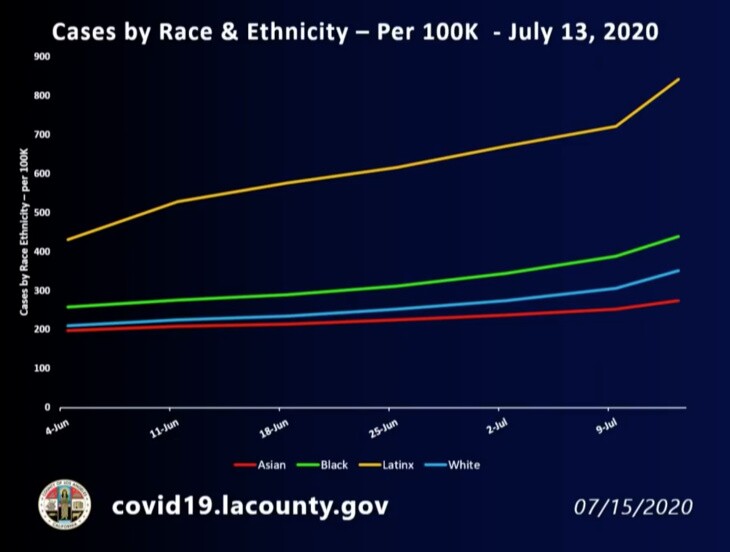This story is free to read because readers choose to support LAist. If you find value in independent local reporting, make a donation to power our newsroom today.
Why LA Is Shifting Its COVID-19 Testing Strategy From Free-For-All To Targeted Access

Our news is free on LAist. To make sure you get our coverage: Sign up for our daily coronavirus newsletter. To support our nonprofit public service journalism: Donate now.
New COVID-19 testing sites for Los Angeles County will target some of the neighborhoods hardest hit by the pandemic, public health officials announced Wednesday. The plans will expand coronavirus testing by 65% in the coming weeks. The testing expansion will focus on underserved "hot-spot" areas of infection, including Montebello, South Gate, Panorama City, Downey, Norwalk and Compton.
Existing testing sites will also be expanding in areas such as Bellflower, Pomona, El Monte and East Los Angeles, according to officials.
The shift in testing comes as the coronavirus pandemic in Los Angeles is at an "alarming and dangerous phase," said Barbara Ferrer, the county's health director. The total number of cases in Los Angeles County crossed the 143,000 mark Wednesday, even as health officials said the death rate has steadily declined.
DON'T MISS ANY L.A. CORONAVIRUS NEWS
Get our daily newsletters for the latest on COVID-19 and other top local headlines.
Terms of Use and Privacy Policy
County data shows that Latinos and people from L.A.'s poorest neighborhoods test positive for the virus at higher rates and are more likely to die. We spoke with Dr. Christina Ghaly, director of the county's Department of Health Services, about the new testing strategy and why it's happening now. (This conversation has been edited for clarity.)
The new county testing sites are opening in areas designated as the county's hotspots. How will you ensure that people from outside of those areas don't sign up for the testing slots?
Certainly, anyone can sign up for a test at any of the city or county-run sites as long as they are a county resident. But I would ask that people respect the data that lies behind the selection of these sites as hotspot areas.
These communities are in need. They are suffering disproportionately from COVID-19. They have higher case rates, higher death rates, and we want these testing sites to be a resource for the people that live there or for people in the surrounding neighboring communities who are also disproportionately affected by COVID.

Who is being disproportionately affected by COVID-19 in L.A. County?
The data from the Department of Public Health on mortality among Black and Latinx communities is over double the fatality rate among white communities. So it's an issue across the board and something that deserves a lot of attention. This is precisely why there's this effort to ramp up testing access among communities at risk.
L.A. County and the state have moved to a tiered testing system. Can you go over the people who are now prioritized for these free tests in the county?
The four general categories of people who are eligible to receive tests are:
- people with symptoms;
- people who live or work in high-risk congregate settings -- so this is people in homeless shelters, nursing homes, or correctional facilities;
- people with unknown exposure -- so whether they were identified and contacted by a contact tracer or they live with someone, for example, who just tested positive for COVID, which counts as a close contact -- so those people should get tested;
- and then the fourth category is essential workers.
So all other individuals, including, notably, people who are over 65 or who have underlying health conditions, are not prioritized in the state and county guidance.

These new rules are really a shift away from the message that we've heard for weeks from various officials, that anyone, including people without symptoms, could get a free test. It's been difficult for people to understand that they may want a test but they don't need a test. Can you explain why it's being changed?
First, it's just an evolving understanding of how this virus spreads, who's most at risk of spreading it, and which are the populations where, if they were tested, it would make a difference in terms of overall transmission. So those are the populations that we really want to get in for testing.
The second thing is, as with anything, ultimately the supply chain is limited. We do have enough test kits and enough testing resources to test all those who need to be tested. But that's not necessarily the same as sufficient testing supplies to test all those who want to be tested. And our obligation first and foremost is to meet the needs of those who need a test before those who want one.

You estimate that one in every 230 people in L.A. County is spreading the virus. Does that mean they're spreading the virus unknowingly?
A lot of them are asymptomatic, and many might be symptomatic, but they're not isolated. They may or may not know that they have COVID. They may or may not consider that they have COVID, but we are estimating that many are infectious and actively infecting others.







